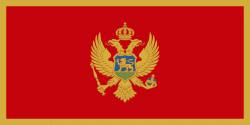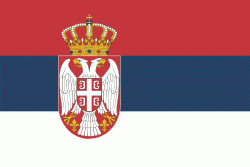Bosnian language
Bosnian (bosanski / босански, ) is the standardized variety of the Serbo-Croatian pluricentric language mainly used by ethnic Bosniaks. Bosnian is one of three such varieties considered official languages of Bosnia and Herzegovina, along with Croatian and Serbian. It is also an officially recognized minority language in Croatia, Serbia, Montenegro, North Macedonia and Kosovo.
Bosnian uses both the Latin and Cyrillic alphabets, with Latin in everyday use. It is notable among the varieties of Serbo-Croatian for a number of Arabic, Persian and Turkish loanwords, largely due to the language's interaction with those cultures through Islamic ties.
Bosnian is based on the most widespread dialect of Serbo-Croatian, Shtokavian, more specifically on Eastern Herzegovinian, which is also the basis of standard Croatian, Serbian and Montenegrin varieties. Therefore, the Declaration on the Common Language of Croats, Serbs, Bosniaks and Montenegrins was issued in 2017 in Sarajevo. Until the 1990s, the common language was called Serbo-Croatian and that term is still used in English, along with "Bosnian-Croatian-Montenegrin-Serbian" (BCMS), especially in diplomatic circles.
Table over the modern Bosnian alphabet in both Latin and Cyrillic, as well as with the IPA value:
Bosnian uses both the Latin and Cyrillic alphabets, with Latin in everyday use. It is notable among the varieties of Serbo-Croatian for a number of Arabic, Persian and Turkish loanwords, largely due to the language's interaction with those cultures through Islamic ties.
Bosnian is based on the most widespread dialect of Serbo-Croatian, Shtokavian, more specifically on Eastern Herzegovinian, which is also the basis of standard Croatian, Serbian and Montenegrin varieties. Therefore, the Declaration on the Common Language of Croats, Serbs, Bosniaks and Montenegrins was issued in 2017 in Sarajevo. Until the 1990s, the common language was called Serbo-Croatian and that term is still used in English, along with "Bosnian-Croatian-Montenegrin-Serbian" (BCMS), especially in diplomatic circles.
Table over the modern Bosnian alphabet in both Latin and Cyrillic, as well as with the IPA value:
Country
-
Bosnia and Herzegovina
Bosnia and Herzegovina (Bosna i Hercegovina), abbreviated BiH or B&H, sometimes called Bosnia–Herzegovina and often known informally as Bosnia, is a country in Southeastern Europe, located in the Balkans. Bosnia and Herzegovina borders Serbia to the east, Montenegro to the southeast, and Croatia to the north and southwest. In the south it has a narrow coast on the Adriatic Sea within the Mediterranean, which is about 20 km long and surrounds the town of Neum. Bosnia, which is the inland region of the country, has a moderate continental climate with hot summers and cold, snowy winters. In the central and eastern regions of the country, the geography is mountainous, in the northwest it is moderately hilly, and in the northeast it is predominantly flat. Herzegovina, which is the smaller, southern region of the country, has a Mediterranean climate and is mostly mountainous. Sarajevo is the capital and the largest city of the country followed by Banja Luka, Tuzla and Zenica.
The area that is now Bosnia and Herzegovina has been inhabited by humans since at least the Upper Paleolithic, but evidence suggests that during the Neolithic age, permanent human settlements were established, including those that belonged to the Butmir, Kakanj, and Vučedol cultures. After the arrival of the first Indo-Europeans, the area was populated by several Illyrian and Celtic civilizations. Culturally, politically, and socially, the country has a rich and complex history. The ancestors of the South Slavic peoples that populate the area today arrived during the 6th through the 9th century. In the 12th century, the Banate of Bosnia was established; by the 14th century, this had evolved into the Kingdom of Bosnia. In the mid-15th century, it was annexed into the Ottoman Empire, under whose rule it remained until the late 19th century. The Ottomans brought Islam to the region, and altered much of the country's cultural and social outlook. -
Montenegro
Montenegro (, Црна Гора, ) is a country in Southeastern Europe. It is a part of the Balkans and is bordered by Bosnia and Herzegovina to the north, Serbia to the northeast, Kosovo to the east, Albania to the southeast, Croatia to the northwest, and the Adriatic Sea to the west with a coastline of 293.5 km. Podgorica, the capital and largest city, covers 10.4% of Montenegro's territory of 13812 km2, and is home to roughly 31% of its total population of 621,000. Cetinje is the former royal capital of Montenegro and is the location of several national institutions, including the official residence of the president of Montenegro.
During the Early Medieval period, three principalities were located on the territory of modern-day Montenegro: Duklja, roughly corresponding to the southern half; Travunia, the west; and Rascia proper, the north. The Principality of Zeta emerged in the 14th and 15th centuries. From the late 14th century to the late 18th century, large parts of southern Montenegro were ruled by the Venetian Republic and incorporated into Venetian Albania. The name Montenegro was first used to refer to the country in the late 15th century. After falling under Ottoman Empire rule, Montenegro gained its semi-autonomy in 1696 under the rule of the House of Petrović-Njegoš, first as a theocracy and later as a secular principality. Montenegro's independence was recognised by the Great Powers at the Congress of Berlin in 1878. In 1910, the country became a kingdom. -
Serbia
Serbia (, ; Serbian: Србија, Srbija, ), officially the Republic of Serbia (Serbian: Република Србија, Republika Srbija, ), is a landlocked country in Southeastern and Central Europe, situated at the crossroads of the Pannonian Basin and the Balkans. It shares land borders with Hungary to the north, Romania to the northeast, Bulgaria to the southeast, North Macedonia to the south, Croatia and Bosnia and Herzegovina to the west, and Montenegro to the southwest, and claims a border with Albania through the disputed territory of Kosovo. Serbia without Kosovo has about 6.7 million inhabitants, about 8.4 million if Kosovo is included. Its capital Belgrade is also the largest city.
Continuously inhabited since the Paleolithic Age, the territory of modern-day Serbia faced Slavic migrations in the 6th century, establishing several regional states in the early Middle Ages at times recognised as tributaries to the Byzantine, Frankish and Hungarian kingdoms. The Serbian Kingdom obtained recognition by the Holy See and Constantinople in 1217, reaching its territorial apex in 1346 as the Serbian Empire. By the mid-16th century, the Ottomans annexed the entirety of modern-day Serbia; their rule was at times interrupted by the Habsburg Empire, which began expanding towards Central Serbia from the end of the 17th century while maintaining a foothold in Vojvodina. In the early 19th century, the Serbian Revolution established the nation-state as the region's first constitutional monarchy, which subsequently expanded its territory. Following casualties in World War I, and the subsequent unification of the former Habsburg crownland of Vojvodina with Serbia, the country co-founded Yugoslavia with other South Slavic nations, which would exist in various political formations until the Yugoslav Wars of the 1990s. During the breakup of Yugoslavia, Serbia formed a union with Montenegro, which was peacefully dissolved in 2006, restoring Serbia's independence as a sovereign state for the first time since 1918. In 2008, representatives of the Assembly of Kosovo unilaterally declared independence, with mixed responses from the international community while Serbia continues to claim it as part of its own sovereign territory.
